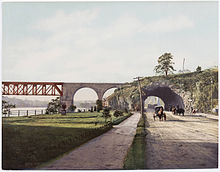Fairmount Park
Fairmount Park is the municipal park system of Philadelphia, Pennsylvania. It consists of 63 parks, with 9,200 acres (3,700 ha), all overseen by the Philadelphia Department of Parks and Recreation, successor to the Fairmount Park Commission in 2010. Fairmount Park is one of the largest urban park systems in the United States.
Fairmount Park proper
Fairmount Park | |
 Fairmount Park. | |
| Location | Both banks of Schuylkill River and Wissahickon Creek, from Spring Garden St. to Northwestern Ave., Philadelphia, Pennsylvania |
|---|---|
| Area | 4,100 acres (1,700 ha) |
| Built | 1812 |
| Architect | Robert Morris Copeland; Olmsted & Vaux et al. |
| Architectural style | Colonial Revival, Georgian, Federal |
| NRHP reference No. | 72001151[1] |
| Added to NRHP | February 07, 1972 |
The park system is named after its first park, Fairmount Park, which occupies nearly half the area of the whole system, at over 4,100 acres (1,700 ha). Today, the commission divides the original park into East and West Fairmount parks. The original domain of Fairmount Park consisted of three areas: "South Park" or the South Garden immediately below the Fairmount Water Works extending to the Callowhill Street Bridge; "Old Park" which encompassed the former estates of Lemon Hill and Sedgeley; and West Park, the area now comprising the Philadelphia Zoo and the Centennial Exposition grounds. The South Garden predated the establishment of the Park Commission in 1867 and Lemon Hill and Sedgeley were added in 1855–56. After the Civil War, work progressed on acquiring and laying out West Park. In the 1870s, the Fairmount Park Commission expropriated properties along the Wissahickon Creek to extend Fairmount Park proper. The Schuylkill River Trail is a modern addition and was not included in 19th-century acquisitions.
Growth

The park grew out of the Lemon Hill estate of Henry Pratt, whose land was originally owned by Robert Morris, signer of the Declaration of Independence. Purchased by the city in 1844, the estate was dedicated to the public by city council's ordinance on September 15, 1855. A series of state and local legislative acts over the next three years increased the holdings of the city. In 1858, the city held a design competition to relandscape Lemon Hill and Sedgeley for public use as the best way to “protect and improve the purity of the Schuylkill water supply."

As the site of the 1876 Centennial Exposition and the first zoo in the United States, the Philadelphia Zoo, Fairmount Park was placed on the National Register of Historic Places on February 7, 1972.
Properties
Today, the system includes the Centennial Arboretum, Philadelphia's Horticulture Center, Fairmount Water Works, Memorial Hall, home to the Please Touch Museum, the Belmont Plateau, Japanese House and Garden, Bartram's Garden (America’s oldest living botanical garden), Philadelphia Museum of Art, Boathouse Row, Azalea Garden, recreation centers, reservoirs, and countless statues (as well as other pieces of art) as determined by the park.
Public art

Fairmount Park is home to a large collection of public art, largely due to the efforts of the Association for Public Art (formerly the Fairmount Park Art Association), a non-profit organization founded in 1872 to embellish Fairmount Park with outdoor sculpture,[2] including the Florentine Lions installed in 1887.[3] The Art Association continues to commission and care for a large number of sculptures, in coordination with the park and city. In 2007, the Art Association installed Iroquois by Mark di Suvero near the Philadelphia Museum of Art on the Benjamin Franklin Parkway.[4]
Houses
Mount Pleasant, built in what was then the countryside outside of the city by a privateer,[5] is now an off-premises [clarification needed] gallery of the Philadelphia Museum of Art in Fairmount Park.[6]
Other houses in the park include William Peters's Belmont Mansion (1745), Hatfield House, Randolph House, Joshua Fisher's The Cliffs (1753), Historic Strawberry Mansion, The Monastery, and the Woodford mansion.


Neighborhood and regional parks
The 63 neighborhood and regional parks are:See also

- Body of Proof episode "Letting Go", which was filmed here.
- Historic Strawberry Mansion
- Schuylkill Banks
- Philadelphia Aquarium
- Subaru Cherry Blossom Festival of Greater Philadelphia
- Sedgley Woods
- Sweetbriar
- Fletcher Street Urban Riding Club
References
- ^ "National Register Information System". National Register of Historic Places. National Park Service. March 13, 2009.
- ^ Richman, M: “Sculpture of a City”, page 54. Walker Publishing Co., 1974.
- ^ si.edu
- ^ Salisbury.S: “Can’t miss this art” a 17½-ton sculpture is installed on the Parkway”, The Philadelphia Inquirer. June 23, 2007.
- ^ "Mount Pleasant". Independence Hall Association.
It was built in 1761–62 by Captain John Macpherson, a privateer who had had "an arm twice shot off" according to John Adams. The pirate called the house "Clunie" after the seat of his family's ancient clan in Scotland.
- ^ Philadelphia Museum of Art. "Fairmount Park Houses: Mount Pleasant".
Scottish ship captain John Macpherson (1726–1792) and his first wife, Margaret, built their grand country estate on this site—high atop cliffs overlooking the Schuylkill River—between 1762 and 1765. They employed as their builder-architect Thomas Nevell (1721–1797), an apprentice of Edmund Woolley, the builder of Independence Hall.
External links
- Fairmount Park Commission, City of Philadelphia
- Map of the Fairmount Park System
- Works Progress Administration, Topographical map of Fairmount Park, 1938
- Philadelphia Zoo
- Please Touch Museum, located in Memorial Hall
- Fairmount Park Art Association
- Public Art in Philadelphia
- Fairmount Park Conservancy
- Article: Cherry Tree Maintenance at Fairmount Park
- Fairmount Park
- Municipal parks in Philadelphia, Pennsylvania
- National Register of Historic Places in Philadelphia, Pennsylvania
- Georgian architecture in Pennsylvania
- Federal architecture in Pennsylvania
- Colonial Revival architecture in Pennsylvania
- 1812 establishments in the United States
- Parks in Philadelphia, Pennsylvania
- Historic districts on the National Register of Historic Places in Pennsylvania
- Works Progress Administration in Pennsylvania
- World's Fair sites in Pennsylvania
- Centennial Exposition



